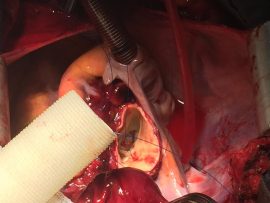Abstract Background/Aim Recent literature suggested that the use of Minimal Invasive Extracorporeal Circulation (MIECC) may mitigate the inflammatory response in patients undergoing cardiac surgery. We aimed to perform a meta-analysis..
Read MoreAbstract Background: Minimally invasive extracorporeal circulation (MiECC) has been introduced to mitigate the inflammatory response and reduce blood transfusion needs compared to conventional cardiopulmonary bypass (CPB) perioperatively. A hybrid system..
Read MoreIntroduction Cardiopulmonary bypass (CPB) has long been a cornerstone of cardiac surgery. However, conventional CPB circuits are associated with a range of physiological disturbances including hemodilution, inflammatory response, and coagulopathy...
Read MoreAbstract Background Management of acute aortic dissection (AAD) caused by retrograde perfusion through the femoral artery during minimally invasive cardiac surgery (MICS) remains controversial. We present a case of AAD..
Read MoreAbstract Background The adoption of minimally invasive cardiac surgery (MICS) has increased over the past 25 to 30 years, driven by advancements in technology and a growing understanding of its..
Read MoreAbstract The concept of mini cardiopulmonary bypass (mini-CPB) has been introduced in clinical practice from early 2000 for advancing perfusion technology aiming to improve cardiac surgical results. The diversity of custom-made..
Read MoreAbstract Objective Minimally invasive extracorporeal circulation has been shown to be non-inferior or even superior to conventional cardiopulmonary bypass circuits in isolated coronary artery bypass grafting, but there is little..
Read MoreAbstract We convened a group of cardiac surgeons, intensivists, and anesthesiologists with extensive experience in minimally invasive cardiac surgery (MICS) and perioperative care to identify the essential elements of a..
Read MoreAbstract Background: This review explores the potential benefits of combining totally endoscopic and robotic-assisted cardiac surgery with minimally invasive extracorporeal circulation (MiECC). Robotic techniques herald a new era of surgical..
Read MoreAbstract Cardiopulmonary bypass (CPB) and veno-arterial extracorporeal membrane oxygenation are critical tools in contemporary cardiac surgery and intensive care, respectively. While these techniques share similar components, their application contexts differ,..
Read MoreAbstract Introduction The trial hypothesized that minimally invasive extra-corporeal circulation (MiECC) reduces the risk of serious adverse events (SAEs) after cardiac surgery operations requiring extra-corporeal circulation without circulatory arrest. Methods..
Read MoreAbstract Background Extracorporeal circulation causes a systemic inflammatory response, that may cause postoperative haemodynamic instability and end-organ dysfunction. This study aimed to investigate the impact of minimal invasive extracorporeal circulation..
Read MoreAbstract The European Congenital Heart Surgeons Association (ECHSA) Congenital Database (CD) is the second largest clinical pediatric and congenital cardiac surgical database in the world and the largest in Europe,..
Read MoreAbstract Background: Cardiopulmonary bypass (CPB) techniques are becoming minimally invasive in clinical practice. The literature describes various extracorporeal techniques which seek to eliminate air-blood contact and reduce both hemodilution and the..
Read MoreAbstract Introduction Cardiac surgery in patients on chronic renal dialysis is associated with significant morbidity and mortality. Minimally invasive extracorporeal circuits (MiECC) have shown a positive impact on patient outcome..
Read MoreAbstract Beside the tremendous developments in cardiac surgical procedures, the use of cardiopulmonary bypass (CPB) remains the gold standard to perform cardiac surgery but is associated with detrimental effects (e.g...
Read MoreAbstract Background Minimally invasive extracorporeal circulation (MiECC) is employed as a strategy to attenuate the physiologic disturbance caused by cardiopulmonary bypass. The aim of this study was to compare the..
Read MoreAbstract Background Minimally invasive extracorporeal circulation (MiECC) is employed as a strategy to attenuate the physiologic disturbance caused by cardiopulmonary bypass. The aim of this study was to compare the..
Read MoreAbstract The landmark 2016 Minimal Invasive Extracorporeal Technologies International Society (MiECTiS) position paper promoted the creation of a common language between cardiac surgeons, anesthesiologists and perfusionists which led to the..
Read MoreAbstract The use of minimized extracorporeal circulation (MiECC) during cardiac surgery is associated with a reduced inflammatory reaction compared to conventional cardiopulmonary bypass (cCPB). Since it is unknown if MiECC..
Read MoreAbstract AIMS OF THE STUDY: Minimally invasive extracorporeal circulation (MiECC) is an established alternative to conventional extracorporeal circulation (CECC) in coronary artery bypass graft surgery (CABG), but data on its use in cardiac reoperations..
Read MoreMinimally invasive extra-corporeal circulation (MIECC) systems have been developed to reduce the inflammatory response by removing the venous reservoir, using smaller priming volumes and reducing the interface between the blood..
Read MoreAbstract Background: During the last decades many efforts have been made to reduce transfusion requirements and adverse clinical effects during cardiopulmonary bypass (CPB). The minimal extracorporeal circulation (MECC) system and the..
Read MoreAbstract Background Patients with coronary artery disease and concomitant heart failure (left ventricular ejection fraction < 35%) requiring myocardial revascularization are at risk of poor long-term prognosis and higher mortality. The benefits..
Read MoreAbstract Objective: Compare the use of blood products and intravenous fluid management in patients scheduled for coronary artery bypass surgery and randomized to minimal invasive extracorporeal circulation (MiECC) and conventional..
Read MoreAbstract Development of minimally invasive cardiac surgery (MICS) served the purpose of performing surgery while avoiding the surgical stress triggered by a full median sternotomy. Minimizing surgical trauma is associated..
Read MoreAbstract The major advantage of MiECC systems’ intrinsic characteristics is that they abet the best applying cardiovascular physiology to intraoperative perfusion, while they ultimately unify all three operative disciplinary techniques..
Read MoreAbstract Introduction: cardiac surgery is continuosly evolving towards a less invasive procedures and different perfusion techniques are also being studied to enhance the results. The aim of this study is to..
Read MoreAbstract Objective: To investigate whether the miniaturized cardiopulmonary bypass (CPB) system decreased the usage of ultrafiltration (UF), and to explore whether the non-UF with miniaturized CPB strategy could get..
Read More









